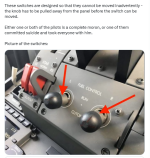butters
High on a Hill
- Joined
- Jul 2, 2009
- Posts
- 85,870
seated close to the escape door, the survivor has no idea how he survived when everyone else died, let alone walked from the crash.
https://www.msn.com/en-us/news/worl...p&cvid=e420b7c10c8e4390870f6345e66e41c0&ei=10
https://www.msn.com/en-us/news/worl...p&cvid=e420b7c10c8e4390870f6345e66e41c0&ei=10



